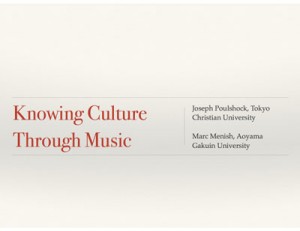This paper, by Poulshock and Menish, was presented at the JALT National Conference in Kobe, Japan on October 26, 2013. Click on the image to download the PDF. Many thanks to all of you who attended our presentation!
Short Summary
We discuss materials and techniques that promote language acquisition and cross-cultural understanding by having university students interact with modern musical movements, genres, and texts. We show ways to engage students critically with the words, stories, songs, and styles of musical art forms. In the end, the results of before and after questionnaires show how students’ attitudes changed regarding music and culture during the course of a semester. (75 Words)
Abstract
We summarize two approaches used in two Japanese universities for using music as a key for understanding cultures. Questionnaire results show how during the term students’ attitudes changed regarding culture and music.
In the first approach, students analyze and discuss key features of popular music. They bring examples of their favorite songs and discuss why those works move them. Aspects of songwriting are then examined so students understand and become familiar with the tools of singer-songwriters. Students then create their own lyrics to a song that tells a story or conveys a feeling.
In small groups, classmates discuss the strengths and weaknesses of their works. They vote for which song they will then bring to life with a performance (and record off site). In class, students listen to and critique the performance. Musical ability is secondary to lyrical content and emotion. A simple song of four voices with hand clapping will count as much as the complex layering of instruments and voices. The ultimate goal is for students to creatively make a work of art using English.
In the second approach, we show how students can engage with significant musical movements and styles, such as blues, jazz, and rock by (1) reading and discussing easy stories about artists and genres, and (2) by listening and responding to representative songs of those genres. We emphasize ways to make stories and songs comprehensible, by simplifying stories and doing information gap activities with songs.

